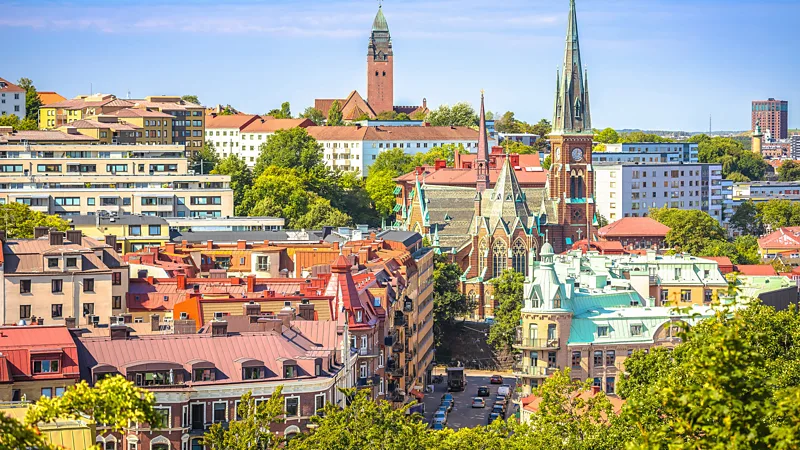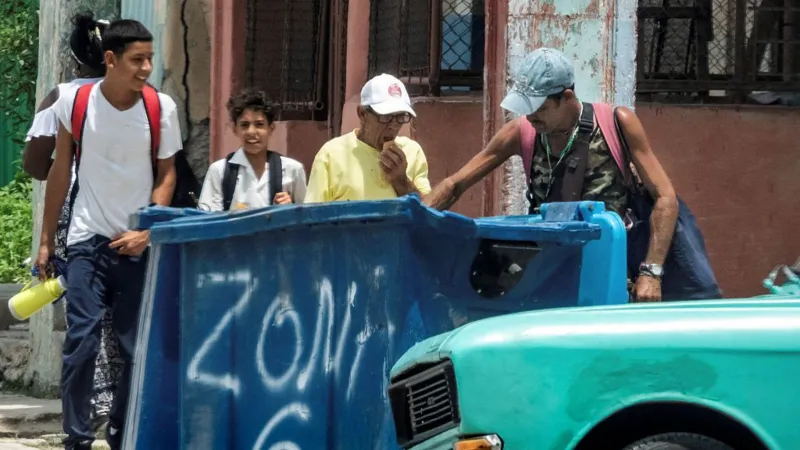Five standout cities making the world a better place
The Global Destination Sustainability Index reveals the destinations that are working towards a sustainable and lower-carbon future.

With time running out to keep global temperature to a 1.5C rise – above which, experts warn, consequences could include far hotter days, higher sea-levels and loss of nearly all the world's coral reefs – implementing solutions for a more sustainable, lower-carbon future is key. And when it comes to destinations, some are proving better at this than others.
The most recent Global Destination Sustainability Index looks at 69 indicators – such as recycling rates, air pollution levels, quantity of cycling paths and the percentage of hotel rooms that are certified eco-friendly – to select the world's most sustainable cities. While the index is geared towards recognising tourism sectors for their sustainability commitments, it also takes into account data that affects city residents – making the index a good resource not only for travellers who want to choose a sustainable destination, but for would-be residents looking to settle in an eco-friendly city, too.
Here are five cities that fare among the best.
Gothenburg, Sweden
The Swedish city ranks top of the Global Destination Sustainability Index, but its bona fides don't end there: Sweden's second-largest city has led the index every year from 2016-2021; was named by Lonely Planet as the world's best sustainable city stay in 2021; and, in 2022, signed up to be one of the EU's 100 cities that plan to be climate-neutral by 2030.
Since moving from Yorkshire, UK, to just outside Gothenburg a year ago, Harriet Pickering and her family have noticed the Swedish city's commitment to sustainability in their everyday lives. Take how they now get around. Her husband is an avid cyclist but found that the traffic and lack of bike paths made cycling more difficult in the UK. "I don't think we would have ever transported our son by cycling. It wouldn't have felt safe enough," Pickering said. "But we do it here. There are cyclists everywhere and loads of cycling paths."
They've even bought an electric car, she added, partly because of how many spaces there are in the area for electric vehicle charging.
But these aren't the only ways in which Gothenburg is helping to cut its residents' and visitors' carbon footprints.
A full 95% of the city's public transport runs on renewable energy, such as its electric buses. Its airport has been certified to one of the highest levels by the Airport Carbon Accreditation scheme, meaning it is committed to tracking, cutting and offsetting carbon emissions; while around nine in 10 of its hotel rooms are environmentally certified. Even its festivals, which can be hefty CO2 emitters, strive to reduce their impact, with Way Out West – which only serves vegetarian meals, sells upcycled garments as merchandise and eschews single-use plates and cutlery – becoming the world's first music festival to be certified sustainable in 2013.
Pickering says living in this environment hasn't just nudged her family to make more sustainable choices in the moment; she also hopes that it will influence her son as he gets older. "He'll just grow up with certain things being the norm," she said. "So, when he's an adult, he won't think twice about things like electric vehicles, or recycling – that will just be part of his normal."
Oslo, Norway
Runner-up on the list – and the second of eight Nordic cities to make the top 10 – is Oslo, which also was named the official European Green Capital in 2019. Perhaps paradoxically, given Norway's economic dependence on oil and gas, the country routinely gets top marks for its sustainability commitments. It makes sense that Oslo, Norway's capital, does, too.
Walk around Oslo, and this commitment is clear. In terms of transport alone, the city has 270 city bike stations, 5,000 electric vehicle charging stations and has introduced electric scooters. Then there's how green the city is, literally. Most of the municipality – 63% – is forest. Another 9% is made up of green areas and city parks.
But many of the sustainability initiatives have been behind the scenes, says Anne-Signe Fagereng, marketing manager of Oslo's tourism board, VisitOSLO. "We do green 'nudging' with the tourists that come here," she said. "When you look at our website, you won't see that we put lots of green leaves everywhere, or call everything 'sustainable'. But we try to make the sustainable choices the more go-to choices, if you will."
The website highlights restaurants like Maaemo, which has received a Michelin Green Star for its sustainable practices; and accommodations like the Thon Hotel Astoria, an environmentally certified budget hotel that cuts its carbon footprint by using renewable energy. VisitOSLO also has developed its own criteria for businesses to receive a "Visit Oslo Responsibly" badge and has dedicated resources like its Green Guide for tourists who want to prioritise sustainable options, too.
Offline, the tourism board is incorporating the same principles. At the tourist office, if a visitor asks for advice on how to get from point A to point B, the staff will provide them with information about public transport first, Fagereng said. The tourism board has also developed a course in sustainable business practice for the travel industry, with topics like reducing wood waste or minimising noise pollution.
Fagereng is realistic about the challenges: as long as flying to a destination remains a necessity, for example, it's all but impossible to say travel anywhere is a "sustainable" choice. But she's optimistic. "As a whole, the travel industry isn't sustainable. But we are really making huge efforts to go in that direction," she said. "Tourism can be a force for good."
Glasgow, Scotland
Even Glasgow's name speaks to its environmental heritage: it comes from the Gaelic word Glaschu, which means "dear green space". Some 1,500 years after its founding, the Scottish city ranks highest of any in the UK (and eighth overall) on the Global Destination Sustainability Index, where it's placed in the top 10 every year since 2016.
Even since she moved to Glasgow 10 years ago, Kathi Kamleitner, who is originally from Vienna, says it's obvious that strides have been taken towards a more sustainable future. In 2023, for example, the city put a low-emissions zone in place, restricting which cars can enter the centre in order to cut down on air pollution. Electric vehicle charging stations have been built, "smart" LED streetlights installed, and there have also been noticeable efforts to boost cycling with bike hire schemes and new bike paths. "The execution wasn't always the best. Sometimes it felt a bit like they got someone to build a bike path who doesn't actually ride a bike," Kamleitner said with a laugh. "But overall, I think it's good to see more of that infrastructure coming into place."
Glasgow also embodies its reputation as a green city, Kamleitner said. Her house at the edge of the city looks over a woodland; but even in the heart of Glasgow, there are numerous parks (the city has more than 90 overall). While there are disparities between neighbourhoods, on average, eight in 10 children in Glasgow live within 400m of a public green space.
Still, the city has hurdles to overcome. Compared to Vienna and Berlin, where she's lived before, Kamleitner says that Glasgow's public transport is more expensive and less extensive. However, she's not surprised that Glasgow consistently performs well. A lot of that, she says, comes down to the attitudes of residents. Circular-economy schemes have become more popular, for example, with more community hubs to repair or lend out products.
"I see a lot of social enterprises and a lot of businesses really pursuing that sustainability aspect, and making it easier to meet more sustainable choices," she said. "And that's certainly something I've seen in Glasgow – more maybe than even in some of the other cities I've lived in."
Bordeaux, France
Most people might know Bordeaux for its stunning architecture and swill-able wine, but there's another reason to fall in love with the French city: it's seeking a more sustainable future. As well as ranking in the top 10 on the Global Destination Sustainability Index, Bordeaux is the third highest-ranked sustainable destination on TripAdvisor.
Walk around the city, and signs of these efforts are everywhere. The city is navigable by self-service V3 bikes, electric buses, trams and even river shuttles, while zero-kilometre restaurants and second-hand stores abound. Around three-quarters of Bordeaux's vineyards and one-third of its tourism companies have been eco-certified, as has its tourist office itself. Even the Bordeaux Wine Festival – this year from 27-30 June – is trying to cut its carbon footprint: eco-certified since 2021, it composts food waste, sells no plastic items and measures and reports on its emissions each year.
But the city is aiming far higher, according to Olivier Occelli, director of the Bordeaux tourism office. The city's tourism sector has committed to getting 80% of its stakeholders, from hotels to tour agencies, to be eco-certified by 2026.
"Sustainability is one major strategy that we have to focus on for the years to come," he said. "We know that global warming is here, and all the economic sectors need, in that sense, to take care of our future, and of the planet."
Of course, as for all the cities on the list, there's plenty of work to do. One thing he and his associates are thinking about, says Occelli, is how to reduce the carbon footprint of the actual travel to Bordeaux itself: after all, staying just one or two nights in a destination is more carbon-intensive than if you stayed longer. "We have to work on that," he said. "And if someone is coming for two days' work, for example, we really have to say okay, you stay two days for work, but stay three more days to visit the city, see the vineyards and to take public transportation within the city." Which – given everything Bordeaux has to offer – doesn't seem like such a punishment.
Goyang, South Korea
Ranking 14th on the list – and the highest of any city outside of Europe – is Goyang, South Korea, where the tourism industry has been hard at work improving its green credentials.
In 2017, Goyang, located just outside of Seoul, became the first city in South Korea to join the Global Destination Sustainability Index. The following year, the index awarded it "Most Improved Destination". It's been climbing up the GDSI rankings ever since. In 2022, it earned its first ISO 20121 sustainability certifications, particularly for its conventions and events. Today, the convention/exhibition centre recycles rainwater for the bathrooms, pond and gardens. The city itself also has 68 parks and a bike sharing system.
"Actively and continuously pursuing sustainability in a small regional city with significantly limited manpower and budget, compared to international cities, was no easy feat," said Peter Lee, managing director of the Goyang Convention and Visitors Bureau.
Aside from initiatives like the convention centre's attempts to cut its carbon footprint, the city has "excellent environmental conditions", Lee says, such as more than 1,000 hectares of "green and blue" (like parks and water) per 100,000 people, and 424km of cycling paths.
"It is a liveable city where rural and urban areas are well harmonised, and it boasts top-notch environmental policies and practical measures within South Korea," Lee said.
-bbc






